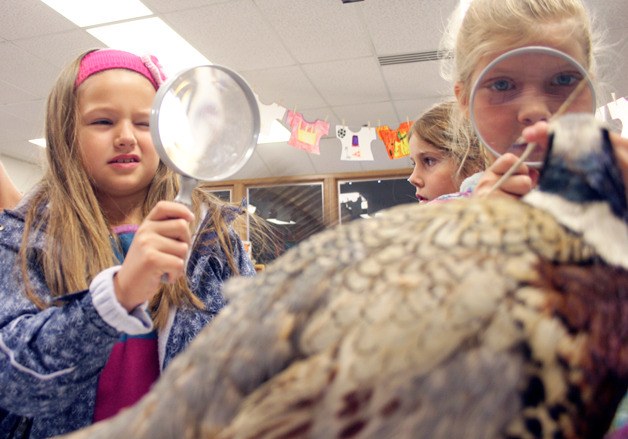There’s a lot to be grossed out by worms.
Their sticky skin, writhing motion and eyeless heads are some of the reasons South Whidbey’s second graders squirmed while studying the creatures.
As Janet Hall explains that the container of soil she has is actually worm poop, the unison ick-factor becomes audible — “ewwwwww.”
Seeing, smelling and touching the worms in compost Monday morning was part of South Whidbey Elementary School’s science kickoff day. All second graders rotated to five stations covering various science and nature-related issues, including worms and soil, beans, bees, birds and gases and solids.
“My kids may not get to insects until spring, so it’s fun for them to know this is coming,” said Leslie Woods, a second grade teacher. “It’s a taste of what’s coming.”
Woods and the other second grade teachers planned the science event to give kids a glimpse of their curriculum. It’s the first year since Woods has taught at the school that such an event happened, and her ultimate goal was to keep kids engaged and interested in lessons that may be months away.
The exhibits also allowed students to have more tactile experiences with some natural world science. They felt owl, pheasant and peacock feathers, held man-made and natural bird nests, examined worms in compost, learned about bee hives and honey cultivation, growing beans and the states of matter. And though each lesson was a short introduction — the whole event lasted two hours — for the little learners with brief attention spans, teachers hope it made a lasting first impression.
“We’re trying to make things more hands-on and connected,” Woods said. “It really generated an excitement about what happened and what can happen.”
Plans are in the works for how the second grade educators can incorporate the kickoff groups, including Whidbey Audubon, Island Apiaries and Waste Wise, into their curriculum this year. Second grade students are expected to learn about life cycles, basic scientific methods of inquiry and investigation, insects, liquids, solids and gases and air and weather. The worm exhibit allowed several of those curriculum points to be hit. Hall explained the nature of worms eating rotting organic matter, such as food waste, then turning that into compost and soil, which in turn nourishes plants that can bear fruit and vegetables, which people eat and in turn create food waste for the worms.
The Whidbey Audubon exhibit was a hit with Sue Raley’s class. Members of the group’s education committee displayed photos of various birds and passed around nests and feathers, including a wing from a barred owl. Jenny Brown swung the wing and asked students to listen for the sound — there was none, she said, because the owl needs to be silent when it hunts. One student examined a feather with an electronic magnifying glass and reported that he saw lots of lines, referring to the strands in the feather.
After the kickoff, Woods had her students write about the experience in their science journals. She was surprised to see diverse interests as students were evenly divided between the five stations.
“That’s exactly what we want, is them thinking, ‘How does this affect me? How can I use this in my life?’” Woods said.



